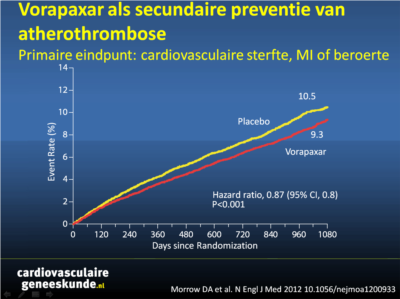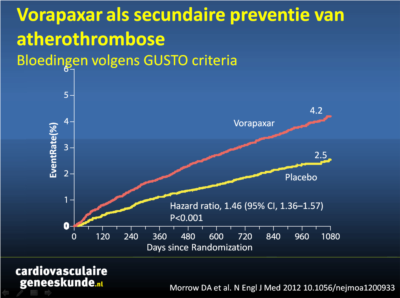ACC 2012: Vorapaxar als secundaire preventie van atherothrombose
Literatuur - Morrow DA et al. N Engl J Med. 2012 Mar 24Morrow DA, Braunwald E, et al.; the TRA 2P–TIMI 50 Steering Committee and Investigators.
N Engl J Med. 2012 Mar 24.
Bij patiënten met stabiele atherosclerose is nog niet vastgesteld dat er minder trombotische events zijn bij plaatjesremmende therapie bovenop aspirine 4.
Vorapaxar (Merck) is een protease geactiveerde receptor 1 (PAR-1) trombine receptor antagonist. Het medicijn remt trombine-geïnduceerde plaatjesaggregatie.
In de Thrombin Receptor Antagonist in Secondary Prevention of Atherothrombotic Ischemic Events (TRA 2P)-Thrombolysis in Myocardial Infarction (TIMI) 50 studie werd de effectiviteit en veiligheid van vorapaxar onderzocht in het verminderen van atherotrombotische events in patiënten met vastgestelde atherosclerose die standaardtherapie kregen. Ook werd bekeken of een intensievere plaatjesremmende therapie door het toevoegen van een middel met een andere farmacologische werking gunstig is voor secundaire preventie bij stabiele patiënten met een voorgeschiedenis van MI, ischemische beroerte of perifeer vaatlijden.
Na 3 jaar was het risico op cardiovasculaire sterfte, MI of beroerte lager bij patiënten met een voorgeschiedenis van MI, CVA of perifeer arterieel vaatlijden die gerandomiseerd waren naar vorapaxar (9,3%), vergeleken met patiënten gerandomiseerd naar placebo (10,5%, P < 0.001) . Cardiovasculaire sterfte, MI, CVA of terugkerende ischemie leidend tot ziekenhuisopname kwam voor bij 11,2% van de patiënten gerandomiseerd naar vorapaxar vs 12,4% gerandomiseerd naar placebo (p = 0.001). Deze reductie in nieuwe cardiovasculaire events was het grootst bij patiënten met een eerder MI; bij hen was er een daling van 20% (P < 0.001).
Vorapaxar was echter geassocieerd met een verhoogd risico op matige of ernstige bloedingen (GUSTO-criteria) na 3 jaar in vergelijking met placebo (4,2% vs 2,5%), inclusief intracraniële bloedingen (1% versus 0,5%; P<0.001 voor beide). Het optreden van bloedingen was minder bij patiënten zonder voorgeschiedenis van een beroerte (0,6% met vorapaxar versus 0,4% met placebo, P = 0,049).
2. Wiviott SD, Braunwald E, McCabe CH, et al. Prasugrel versus clopidogrel in patients with acute coronary syndromes. N Engl J Med 2007;357:2001-15.
3. Wallentin L, Becker RC, Budaj A, et al. Ticagrelor versus clopidogrel in patients with acute coronary syndromes. N Engl J Med 2009;361:1045-57.
4. Bhatt DL, Fox KA, Hacke W, et al. Clopidogrel and aspirin versus aspirin alone for the prevention of atherothrombotic events. N Engl J Med 2006;354:1706-17.
Methods We randomly assigned 26,449 patients who had a history of myocardial infarction, ischemic stroke, or peripheral arterial disease to receive vorapaxar (2.5 mg daily) or matching placebo and followed them for a median of 30 months. The primary efficacy end point was the composite of death from cardiovascular causes, myocardial infarction, or stroke. After 2 years, the data and safety monitoring board recommended discontinuation of the study treatment in patients with a history of stroke owing to the risk of intracranial hemorrhage.
Results At 3 years, the primary end point had occurred in 1028 patients (9.3%) in the vorapaxar group and in 1176 patients (10.5%) in the placebo group (hazard ratio for the vorapaxar group, 0.87; 95% confidence interval [CI], 0.80 to 0.94; P<0.001). Cardiovascular death, myocardial infarction, stroke, or recurrent ischemia leading to revascularization occurred in 1259 patients (11.2%) in the vorapaxar group and 1417 patients (12.4%) in the placebo group (hazard ratio, 0.88; 95% CI, 0.82 to 0.95; P=0.001). Moderate or severe bleeding occurred in 4.2% of patients who received vorapaxar and 2.5% of those who received placebo (hazard ratio, 1.66; 95% CI, 1.43 to 1.93; P<0.001). There was an increase in the rate of intracranial hemorrhage in the vorapaxar group (1.0%, vs. 0.5% in the placebo group; P<0.001).
Conclusions Inhibition of PAR-1 with vorapaxar reduced the risk of cardiovascular death or ischemic events in patients with stable atherosclerosis who were receiving standard therapy. However, it increased the risk of moderate or severe bleeding, including intracranial hemorrhage.
N Engl J Med. 2012 Mar 24.
Achtergrond
Plaatjesremmers kunnen trombotische events bij patiënten met ACS verminderen (al is er een toegenomen bloedingsrisico) 1-3Bij patiënten met stabiele atherosclerose is nog niet vastgesteld dat er minder trombotische events zijn bij plaatjesremmende therapie bovenop aspirine 4.
Vorapaxar (Merck) is een protease geactiveerde receptor 1 (PAR-1) trombine receptor antagonist. Het medicijn remt trombine-geïnduceerde plaatjesaggregatie.
In de Thrombin Receptor Antagonist in Secondary Prevention of Atherothrombotic Ischemic Events (TRA 2P)-Thrombolysis in Myocardial Infarction (TIMI) 50 studie werd de effectiviteit en veiligheid van vorapaxar onderzocht in het verminderen van atherotrombotische events in patiënten met vastgestelde atherosclerose die standaardtherapie kregen. Ook werd bekeken of een intensievere plaatjesremmende therapie door het toevoegen van een middel met een andere farmacologische werking gunstig is voor secundaire preventie bij stabiele patiënten met een voorgeschiedenis van MI, ischemische beroerte of perifeer vaatlijden.
Belangrijkste resultaten
Na 3 jaar was het risico op cardiovasculaire sterfte, MI of beroerte lager bij patiënten met een voorgeschiedenis van MI, CVA of perifeer arterieel vaatlijden die gerandomiseerd waren naar vorapaxar (9,3%), vergeleken met patiënten gerandomiseerd naar placebo (10,5%, P < 0.001) . Cardiovasculaire sterfte, MI, CVA of terugkerende ischemie leidend tot ziekenhuisopname kwam voor bij 11,2% van de patiënten gerandomiseerd naar vorapaxar vs 12,4% gerandomiseerd naar placebo (p = 0.001). Deze reductie in nieuwe cardiovasculaire events was het grootst bij patiënten met een eerder MI; bij hen was er een daling van 20% (P < 0.001).Vorapaxar was echter geassocieerd met een verhoogd risico op matige of ernstige bloedingen (GUSTO-criteria) na 3 jaar in vergelijking met placebo (4,2% vs 2,5%), inclusief intracraniële bloedingen (1% versus 0,5%; P<0.001 voor beide). Het optreden van bloedingen was minder bij patiënten zonder voorgeschiedenis van een beroerte (0,6% met vorapaxar versus 0,4% met placebo, P = 0,049).
 Kaplan-Meier curves van het primaire eindpunt (cardiovasculaire sterfte, MI of beroerte. Kaplan-Meier curves van het primaire eindpunt (cardiovasculaire sterfte, MI of beroerte.Klik op de afbeelding om te vergroten. |
Conclusie
Het toevoegen van vorapaxar aan de standaard plaatjesremmende therapie vermindert het risico op cardiovasculaire sterfte en ischemische complicaties bij patiënten met stabiele atherosclerose aanzienlijk. De kans op bloedingen, inclusief intracraniële bloedingen (ICH), neemt echter wel toe; dit risico is lager bij patiënten zonder eerder doorgemaakte beroerte.Referenties
1. Yusuf S, Zhao F, et al. Effects of clopidogrel in addition to aspirin in patients with acute coronary syndromes without ST-segment elevation. N Engl J Med 2001;345:494-502. [Errata, N Engl J Med 2001;345:1506, 1716.]2. Wiviott SD, Braunwald E, McCabe CH, et al. Prasugrel versus clopidogrel in patients with acute coronary syndromes. N Engl J Med 2007;357:2001-15.
3. Wallentin L, Becker RC, Budaj A, et al. Ticagrelor versus clopidogrel in patients with acute coronary syndromes. N Engl J Med 2009;361:1045-57.
4. Bhatt DL, Fox KA, Hacke W, et al. Clopidogrel and aspirin versus aspirin alone for the prevention of atherothrombotic events. N Engl J Med 2006;354:1706-17.
Abstract
Background Thrombin potently activates platelets through the protease-activated receptor PAR-1. Vorapaxar is a novel antiplatelet agent that selectively inhibits the cellular actions of thrombin through antagonism of PAR-1.Methods We randomly assigned 26,449 patients who had a history of myocardial infarction, ischemic stroke, or peripheral arterial disease to receive vorapaxar (2.5 mg daily) or matching placebo and followed them for a median of 30 months. The primary efficacy end point was the composite of death from cardiovascular causes, myocardial infarction, or stroke. After 2 years, the data and safety monitoring board recommended discontinuation of the study treatment in patients with a history of stroke owing to the risk of intracranial hemorrhage.
Results At 3 years, the primary end point had occurred in 1028 patients (9.3%) in the vorapaxar group and in 1176 patients (10.5%) in the placebo group (hazard ratio for the vorapaxar group, 0.87; 95% confidence interval [CI], 0.80 to 0.94; P<0.001). Cardiovascular death, myocardial infarction, stroke, or recurrent ischemia leading to revascularization occurred in 1259 patients (11.2%) in the vorapaxar group and 1417 patients (12.4%) in the placebo group (hazard ratio, 0.88; 95% CI, 0.82 to 0.95; P=0.001). Moderate or severe bleeding occurred in 4.2% of patients who received vorapaxar and 2.5% of those who received placebo (hazard ratio, 1.66; 95% CI, 1.43 to 1.93; P<0.001). There was an increase in the rate of intracranial hemorrhage in the vorapaxar group (1.0%, vs. 0.5% in the placebo group; P<0.001).
Conclusions Inhibition of PAR-1 with vorapaxar reduced the risk of cardiovascular death or ischemic events in patients with stable atherosclerosis who were receiving standard therapy. However, it increased the risk of moderate or severe bleeding, including intracranial hemorrhage.


Deel deze pagina met collega's en vrienden: